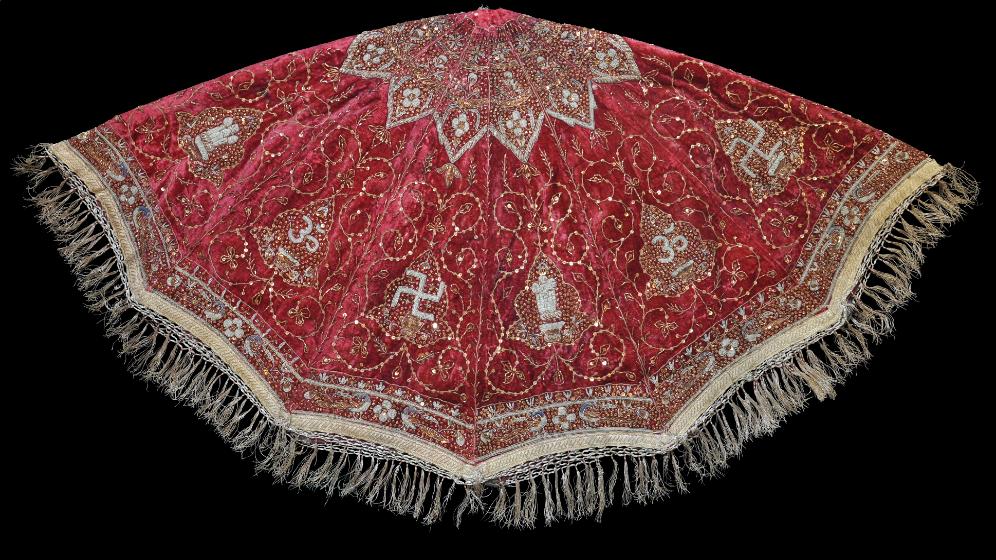
Umbrella Covering, India, circa 1900
Temple Umbrella Covering
Rajasthan, India
circa 1900
approximate diameter: 140cm
This umbrella cover of red velvet and has been decorated with metallic and cream threads and metallic sequins or spangles using a technique known as zardozi work.
Used either for Hindi or perhaps Jain rituals, this umbrella would have been used to shelter a religious figure or even a statue from the sun during a ceremony or procession. It might also have been used by one of Indian’s many royal houses. Umbrellas have long been an important symbol of royalty in India – a practice that spread to Southeast Asia. The possibility of Jain use is suggested by some of the motifs which are shared with Hindus but also because Jains preferred to decorate their shrines with hangings in
zardozi work rather than the painted textiles (pichhavai) preferred by Hindus.
The cover is couched and embroidered with the
Om symbol, the reverse swastika, and what appears to be a symbol based on the lion terminal of the Ashoka pillar. The central panel is closely embroidered and couched with flower motifs, and the outer border is decorated with multiple pairs of peacocks amid flowers.
The edge of the cover is fully lined with a fringe of gold thread tassels.
A related umbrella in the National Gallery of Australia (see Maxwell, 2003a, p. 118) is attributed to early 20th century Rajasthan but was traded to Java, Indonesia, from where it was collected, and where it is believed to have been used by royalty for processions.
Zardozi work involves adding raised gold embroidery to velvet, and was probably introduced to India by the Portuguese. Many Indian royal houses commissioned zardozi embroiderers to embellish jackets, shoes, umbrellas and other articles with this work that were to be worn and used in the court. The zardozi embroiderers typically were Muslim men.
The umbrella cover has no insect damage or other holes. There are some loose threads here and there and minor losses however.
For display purposes, the cover can be readily slipped over a modern umbrella which can then be opened, so that this cover can be seen in its full magnificence.
References
Arts of India: Virginia Museum of Fine Arts, Philip Wilson Publishers, 2001.
Allen, C.,
Maharajas: Resonance from the Past, Mercury Books, 2005.
Maxwell, R.,
Sari to Sarong: Five Hundred Years of Indians and Indonesian Textile Exchange, NGA, 2003a.
Maxwell, R.,
Textiles of Southeast Asia: Tradition, Trade and Transformation, Periplus, 2003b.
Provenance
UK art market
Inventory no.: 4068
SOLD


